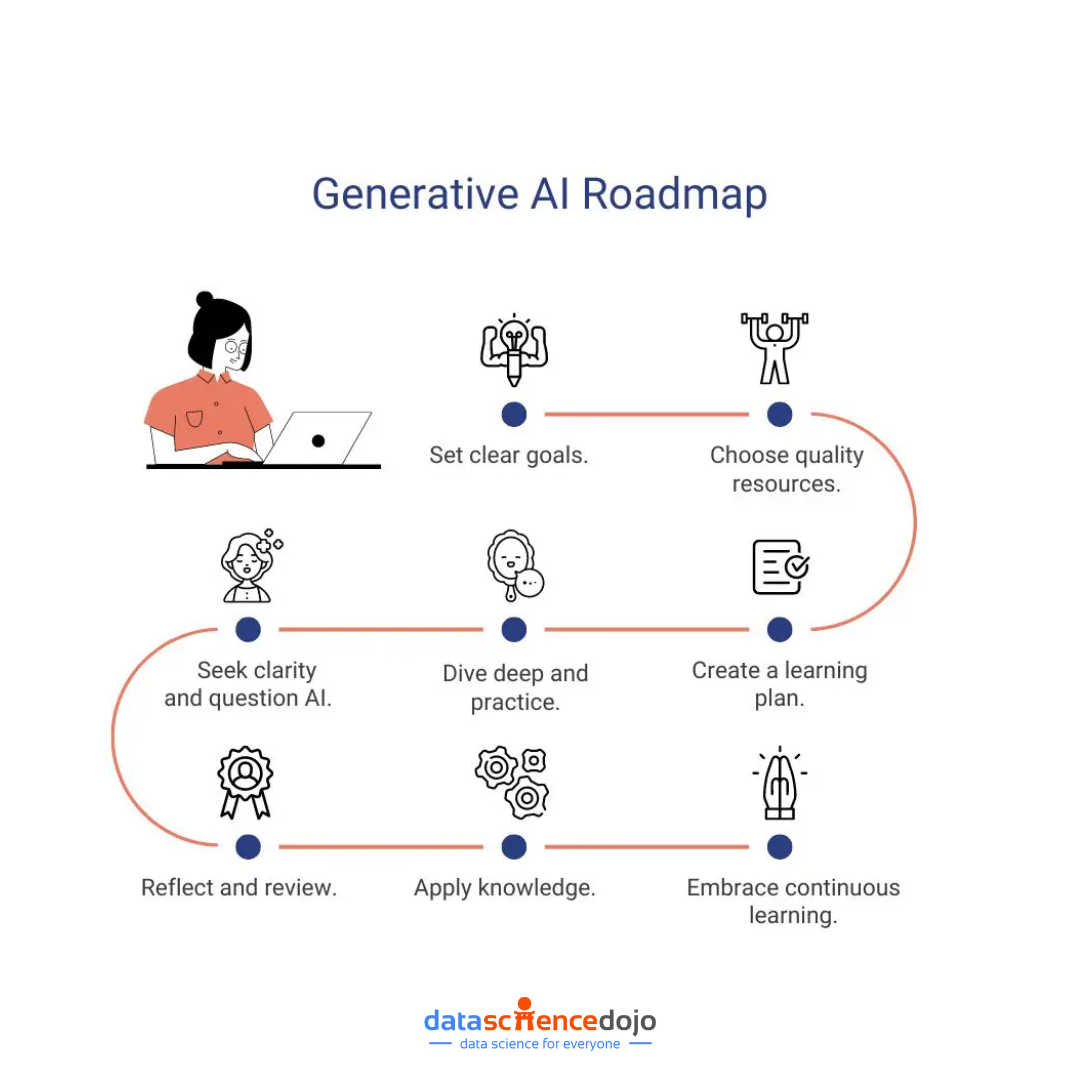This is your cue to level up your skills with our Generative AI Roadmap for beginners! No need to search any further – we’ve got you covered with the basics, career paths, and learning strategies. Let’s dive in!
For the unknown, generative AI, an exciting field of Artificial Intelligence, promises to transform automation, creativity, and decision-making. With a foundation in math, statistics, and programming, learning Generative AI requires dedication and patience as the technology evolves.
Back to Basics: What is Generative AI?
Generative AI, often called GenAI, refers to a class of artificial intelligence models that can generate new, original content based on the data they have been trained on.
Unlike traditional AI, which typically focuses on classification or prediction, GenAI creates—whether it’s text, images, audio, or even code. It leverages advanced deep learning techniques, particularly models like Generative Adversarial Networks (GANs) and transformers, to understand input prompts and produce human-like outputs in response.
This shift from rule-based systems to generative models introduces a form of computational creativity. GenAI enables machines to mimic human expression, offering tools that can write essays, generate realistic images, compose music, simulate conversations, and more.
Applications of Generative AI are vast and still growing. It’s being used in natural language processing (NLP) for chatbots and language translation, in computer vision for image enhancement and generation, and in fields like autonomous driving, robotics, and drug discovery where simulation and optimization are crucial.
In essence, GenAI is reshaping the boundaries of what machines can do, blurring the line between human and machine-generated content and opening up exciting possibilities across industries.
How Does Generative AI Work?
Before diving into the Generative AI roadmap, it’s important to understand how this transformative technology operates. At its core, Generative AI uses machine learning models—particularly large language models (LLMs) and neural networks—to analyze vast datasets and generate new, contextually relevant content. A popular example is OpenAI’s ChatGPT, which is trained on a massive corpus of text data to understand language patterns, syntax, and semantics.
GenAI doesn’t just regurgitate information—it learns the structure and logic behind the data, allowing it to create something entirely new. For instance, in design and marketing, it can automate creative tasks, generate ad copy, draft email campaigns, or even produce visuals. In doing so, it streamlines workflows while maintaining consistency and quality.
By reducing manual effort, GenAI accelerates innovation across sectors. From enhancing product development with AI-generated prototypes to transforming the customer experience through hyper-personalized interactions, its wide-reaching capabilities make it an indispensable tool in the digital age. Simply put, Generative AI unlocks speed, scale, and creativity—all while empowering teams to focus on high-level strategy.

Generative AI Roadmap: How to Learn It?
Why do people want to learn GenAI? The answer is simple. Generative AI will save you time, no matter what your job is. So this generative AI roadmap provides you a direction on how you need to jump on this tech bandwagon.
Set Exciting Goals: What do you want to achieve with generative AI? Create innovative products? Automate tasks? Set clear goals that inspire you and tailor your learning journey accordingly.
Discover Quality Resources: Explore a variety of resources like online courses, books, and tutorials. Find the ones that resonate with your learning style and are relevant to your goals. Don’t settle for average—choose the best!
Craft a Learning Adventure: Design a learning plan that breaks down your goals into manageable tasks. Schedule regular time for exploration and growth. Make it an exciting adventure rather than a mundane task.
Dive Deep and Practice: Immerse yourself in generative AI. Take deep dives into the concepts and practice your skills. Code, experiment, participate in hackathons, and contribute to real-world projects. It’s hands-on fun!
Seek Clarity and Question: Ask questions, seek answers, and engage with others in the field. Join online forums, connect on Slack, and interact with mentors. Keep your curiosity alive and embrace the joy of learning.
Reflect and Review: Reflect on your progress, celebrate your achievements, and brainstorm new ideas. Unleash your creativity to envision exciting projects and possibilities. Let your imagination soar!
Embrace Challenges: Challenges are stepping stones to growth. Embrace them as opportunities to learn and overcome obstacles. Stay motivated by setting small goals, celebrating successes, and connecting with fellow learners.
Apply and Innovate: Put your knowledge to work! Apply generative AI in real-world scenarios. Explore its potential applications, solve problems creatively, and consider ethical implications. Be a catalyst for innovation!
Embrace Continous Learning: Generative AI is a dynamic field. Stay ahead by embracing continuous learning. Stay updated with advancements, expand your knowledge base, and develop problem-solving skills.
Careers in Generative AI
Since we are talking about a Generative AI roadmap, the discussion cannot be concluded without inspecting the future jobs that might storm the market due to the huge demand for generative AI.
1. AI Engineer
AI Engineers are the architects behind intelligent systems that mimic human decision-making and behavior. Their work often involves designing and deploying models for machine learning, computer vision, or natural language processing (NLP). In the context of Generative AI, they might build applications like image generators, chatbots, or recommendation engines.
These professionals need a solid grasp of Python, TensorFlow, PyTorch, and cloud platforms like AWS or Azure. A strong foundation in math, statistics, and data structures is also key. AI Engineers are critical in turning complex AI models into practical tools used across healthcare, finance, e-commerce, and more.
2. Prompt Engineer
This list includes a lot of tech-heavy roles, but you don’t need to be a programmer to work with AI. Being really good at writing prompts for chatbots is an in-demand skill to have on your resume if you want to become a Prompt Engineer.
AI needs to understand its users, which is no easy task considering the ambiguities of human communication. The way we ask ChatGPT for information can affect the types of responses we get. Prompt Engineers figure out exactly how to word a command to achieve a desired result, and they help evaluate AI performance and uncover flaws by testing models with specialized and specific prompts.
Prompt engineering helps ensure that AI can properly interpret and respond to our commands, and companies will doubtlessly need native speakers of different languages and dialects worldwide to help train their models.
3. Algorithm Engineer
Algorithm Engineers are the masterminds behind the mathematical backbone of Generative AI. Their job is to design, test, and optimize algorithms that allow AI systems to learn, reason, and improve. These professionals ensure models are efficient, accurate, and scalable.
Their work requires expertise in data structures, optimization techniques, and programming languages like C++, Java, and Python. They also need a deep understanding of machine learning theory, reinforcement learning, and sometimes even quantum computing. In generative applications, they might focus on optimizing generation logic or developing new architectures like transformers and GANs.
4. NLP Engineer
NLP Engineers build AI models that understand, process, and generate human language. Their work powers systems like voice assistants, chatbots, and translation tools—but also enables sentiment analysis, spam detection, and more. In Generative AI, NLP Engineers may fine-tune LLMs for specific tasks or create datasets for language modeling.
They often work with Python, libraries like spaCy, NLTK, Hugging Face Transformers, and platforms like BERT and GPT. A strong background in linguistics and computer science helps them tackle the challenges of ambiguity, context, and cultural nuance in language. As human-AI interaction continues to grow, demand for skilled NLP Engineers is soaring.
Conclusion
GenAI has the potential to revolutionize daily life. It enables accurate decisions, cost reduction, and improved efficiency in various fields. Recommended roadmaps for beginners, intermediates, and advanced users are available to learn generative AI effectively. As we explore this technology further, it will become indispensable in all industries, providing new opportunities for growth and innovation through automated decision-making. We hope this Generative AI Roadmap blog is helpful.





